![]()
| Yunnan, China | Lijiang | 2002.05.06 - 05.16 |
Old Town and Surroundings
Lijiang has an old town that's touristy but retains an authentic feel. After having destroyed the traditional spirit in Dali, the Chinese authorities seem to have learned a lesson. When a strong earthquake toppled a large portion of Lijiang in 1997, the government rebuilt Old Lijiang in traditional fashion with stone walkways, wooden buildings and bridges, and waterways. The ancient feel of Old Lijiang is preserved. Throughout the city, the spirit of the indigenous Naxi Tribe appears to be strong.
Accommodation and restaurants are plentiful in Old Lijiang, and prices vary widely. The Youth Hostel charges high prices compared to family run guesthouses. Nevertheless, it's a conspicuous landmark from which the location of most other buildings in Old Lijiang can be described.
Most travelers stay in Lijiang for several days to explore the Old Town and also use it as a base from which to explore Lugu Lake (7 hours northeast by bus) and Tiger Leaping Gorge (2 hours north by bus). Both are two or more day excursions. Guesthouses in Lijiang are accustomed to store luggage for several days until their guests return.
We highly recommend two places in Old Lijiang. Anyone suffering from fatigue, tension, pain, or imbalance should see Dr. Xiao. His storefront sign advertises Chinese massage, but he in fact practices energy healing like Kikou or Qigong. Comments from his patients range from the nondescript, "Best massage I've ever had," to more convincing descriptions of relief from specific disorders. Our experience with Dr. Xiao was powerful. A one-hour session with Dr. Xiao leaves the body tingling and limp for about 30 minutes. He applies little physical pressure, but the level of energy transmission on the body's receptors is enormous. After balancing our bodies, Masami ran a fever and we both urinated frequently. It was as if over the next 24 hours our bodies were expelling collected toxins. Two days later, we felt much healthier than before. Pinched nerves and muscle tension were gone. Find Dr. Xiao's office on the bank of the stream running through Old Lijiang.
Of the many restaurant options, our favorite is Ji Xian Guan on the bank of the stream between Dr. Xiao's place and the Youth Hostel.
GETTING TO LIJIANG
Lijiang is a bus hub for most destinations in Yunnan Province. Buses travel between
Lijiang and all other cities in Yunnan several times each day.
LUGU LAKE
The 7-hour bus ride (with transfer in Ninglang) to Lugu Lake crosses winding
mountainous roads with spectacular views of mountains and gorges dotted with
unbelievably remote and seemingly inaccessible villages (connected with electricity
and satellite TV! See our Old Dali page
concerning government allocated TV reception.)
The lake itself is in a gorgeous setting but the majority of the population inhabiting its banks have been warped by the government's tourist advertisement campaign to such an extent that visits are somewhat unappealing. We were fortunate to meet two students on a study abroad program from US universities. Peng and Tim enlightened us on the history of indigenous Mosuo (a subgroup of Naxi) culture, the Han Chinese misrepresentation of it in their campaign to promote Lugu Lake as a tourist site, and the subsequent Chinese intervention to ultimately alter the Mosuo civilization to correspond with their tourism advertisement claims. Upon arrival in Luoshui Village on the shore of Lugu Lake, we immediately sensed that something wasn't authentic about the traditionally dressed Mosuo people nor the feel of the town. Peng and Tim's findings during their 2.5 week research in the area confirmed our misgivings.
To briefly summarize, the Mosuo people historically practiced a family structure different than our concept of marriage. A man and woman would engage in a long-term relationship but continue to reside separately at one's mother's house. Children from the relationship would be the woman's property, and the man would provide financial support for the duration of the relationship. Property, such as land, would be inherited down the female line. However, the society wasn't matriarchal because only men held government office. In an effort to promote Lugu Lake as an interesting tourist spot, the Chinese government advertised the area as "the Woman's Kingdom", a fully matriarchal society, and implied that the women are sexually loose, taking male partners often, and at will. Books with promiscuous covers and amateur paintings with naked and scantily clad women are sold in every shop. Locals are forced to wear "traditional costumes" with the threat of ¥20 per day fines for non-compliance. And the government is positioning women in the local government. Today, although only 40% of the population of a tiny remote village some 30km distant from Lugu Lake continues to practice the traditional Mosuo family system, Chinese government controls are forcing the whole Lugu Lake population to have an outward appearance that complies with their tourism advertising campaign.
We weren't impressed with the distorted local culture and never felt comfortable at Lugu Lake. We cut our intended stay short and returned to Lijiang.
On our return, we stopped in Ninglang for 2 hours to photograph a subgroup of the Yi Tribe who wear large square black hats. We don't recommend a stay in Ninglang longer than a few hours because there's nothing else to see nor do there.
TIGER LEAPING GORGE
A fabulous 2~3 day walk near Lijiang is through Tiger Leaping Gorge. Despite its
popularity, numerous tourists, and recent road construction, the gorge's high trail
is a fairly lengthy but easy walk with spectacular scenery. Snowcapped 5000+ meter
peaks rise above either side of the 1700-meter high gorge. The trail crosses
several waterfalls dropping hundreds of meters into the raging river below.
Two routes through the gorge are possible. One crosses east-west between the towns of Daju (5 hours by bus from Lijiang) and Qiaotou (2 hours by bus from Lijiang). The other route starts and ends in Qiaotou along the high route going and the low route (a road) on the return. Two admission fees apply depending on the route taken. Entry into Tiger Leaping Gorge costs ¥30 per person (¥15 with student card). Ticket offices are on either side of the gorge entrance. South of the gorge is a national park containing Daju. Crossing through this park to Daju on the bus from Lijiang costs an additional ¥40 per person (¥20 with student card). This ¥40 fee is avoided on the Qiaotou round-trip loop.
Collect a free trail map at the tourist restaurants in Lijiang. Ma Ma Fu's Cafe normally has a large stack.
Along the trail, the Halfway Guesthouse and Sean's Guesthouse seem to be the best. A 2-day trek requires an overnight in the village where the Halfway Guesthouse is located. A 3-day trek includes an overnight in Walnut Grove where Sean's Guesthouse is. Near the Halfway Guesthouse are some other guesthouse options. If starting the trek late in the day, alternate accommodation is found every 2 to 3 hours walking time on the high trail. There's never a worry of being stranded overnight on this hike.
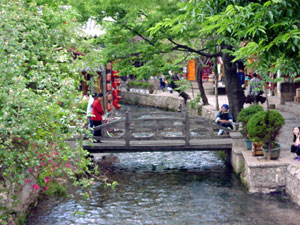 |
The old section of Lijiang has stone pedestrian walkways, old buildings, waterways, and wooden bridges. |
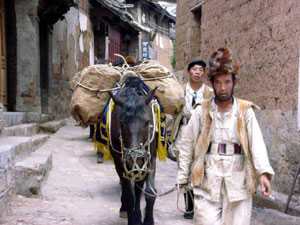 |
Many afternoons, hunters return to Lijiang with their horses and rifles. |
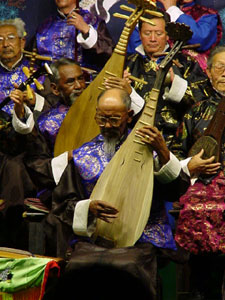 |
The Naxi Orchestra in old Lijiang is a colorful affair. The music, however, is a chore to sit through. |
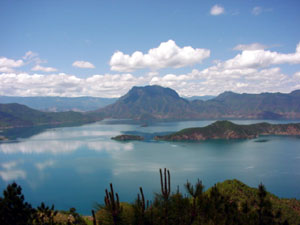 |
The drive into Lugu Lake is the most beautiful part of the journey. The southern shore is in Yunnan Province, and the northern shore is in Sichuan Province. |
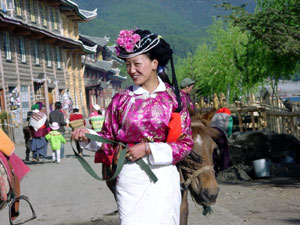 |
The Mosuo people at Lugu Lake are fined if seen out of costume. |
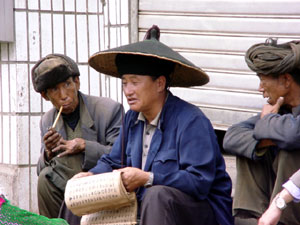 |
A fortune teller on the streets of Ninglang attracts local villagers. |
 |
The Yi Tribe women living between Lijiang and Lugu Lake wear large square hats. Many are found at the market in Ninglang. |
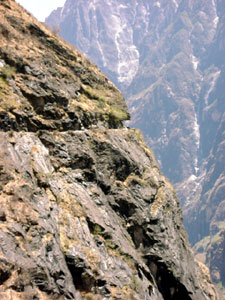 |
Sections of the high trail through Tiger Leaping Gorge are cut through cliff rock. |
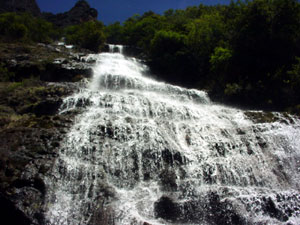 |
The Tiger Leaping Gorge high trail passes gorgeous, refreshing waterfalls. |
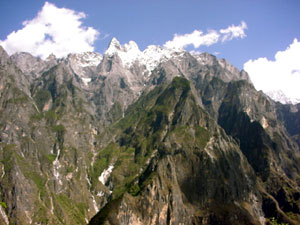 |
A hike up 1400 vertical meters from the Tiger Leaping Gorge Halfway Guesthouse reaches a viewpoint at 3800 meters. The snowcaps on the opposite side of the gorge reach 5300 meters. |
Copyright © 2000-2002 Wes and Masami Heiser. All rights reserved.